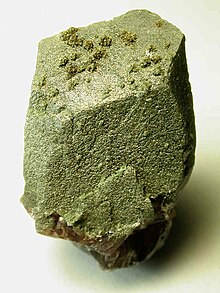| Chamosite | |
|---|---|
 A 3.6 by 2.2 cm of Axinite-Fe covered on both sides by greenish microcrystals of Chamosite | |
| General | |
| Category | Phyllosilicate |
| Formula (repeating unit) | (Fe2+,Mg)5Al(AlSi3O10)(OH)8 |
| IMA symbol | Chm[1] |
| Strunz classification | 9.EC.55 |
| Crystal system | Monoclinic |
| Crystal class | Prismatic (2/m) (same H-M symbol) |
| Space group | C2/m |
| Unit cell | a = 5.37 Å, b = 9.3 Å, c = 14.22 Å; β = 97.88°; Z = 2 |
| Identification | |
| Color | Green, grey-green, black |
| Mohs scale hardness | 3 |
| References | [2][3][4] |
Chamosite is the Fe2+end member of the chlorite group. A hydrous aluminium silicate of iron, which is produced in an environment of low-to-moderate-grade metamorphosed iron deposits, as gray or black crystals in oolitic iron ore. Like other chlorites, it is a product of the hydrothermal alteration of pyroxenes, amphiboles and biotite in igneous rock. The composition of chlorite is often related to that of the original igneous mineral, so that more Fe-rich chlorites are commonly found as replacements of the Fe-rich ferromagnesian minerals (Deer et al., 1992).
- ^ Warr, L.N. (2021). "IMA–CNMNC approved mineral symbols". Mineralogical Magazine. 85 (3): 291–320. Bibcode:2021MinM...85..291W. doi:10.1180/mgm.2021.43. S2CID 235729616.
- ^ Webmineral.com
- ^ Mindat.org
- ^ Handbook of Mineralogy